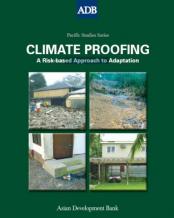Climate Proofing: A Risk-based Approach to Adaptation

Posted by
CAKE Site AdminPublished
Abstract
[Executive Summary] The Pacific islands region faces increasing environmental and socioeconomic pressures exacerbated by global climate change and climate variability. Adaptation to climate change and variability (CCV) is ultimately an issue of sustainable development. Even without climate change, Pacific island countries are already severely affected by climate variability and extremes, and they remain extremely vulnerable to future changes in the regional climate that could increase the risks. Countries in the Pacific have clearly recognized the need to (i) reduce their vulnerability to these increasing risks through adaptation, and (ii) strengthen their human and institutional capacities to assess, plan, and respond to these challenges. Six case studies designed to assist countries to adapt to current and future climate risks have been prepared. The case studies were prepared through a regional technical assistance under the Renewable Energy, Energy Efficiency, and Climate Change (REACH) programme of the Asian Development Bank, and funded by the Canadian Cooperation Fund for Climate Change – Greenhouse Gas Abatement, Carbon Sequestration and Adaptation. The technical assistance was administered by the Asian Development Bank as the executing agency, and implemented in partnership with the Governments of the Federated States of Micronesia and of the Cook Islands (implementing agencies), Maunsell (NZ) Ltd (environmental and engineering consultancy) and the International Global Change Institute, University of Waikato, New Zealand. The ultimate aim of the case studies is to show why and demonstrate how reducing climate-related risks is an integral part of sustainable development. The overall goal of a risk-based approach to climate change adaptation is to manage both the current and future risks associated with the full spectrum of atmospheric and oceanic hazards. Through a consultative process the following case studies were selected: (i) the Federated States of Micronesia - “climate proofing” a coastal community in Pohnpei; a roading infrastructure project in Kosrae; and the infrastructure, human health and environment components of the National Strategic Development Plan; (ii) the Cook Islands - “climate proofing” the design of the breakwater for the newly developed Western Basin, Rarotonga; a community inland from Avatiu Harbour; and the National Sustainable
Development Strategy. As part of the case studies, assessments were made of both the risks arising from current climate variability and extremes and from the future, incremental changes in those risks as a result of longer-term changes in climate extremes and variability. While the field studies and other activities to develop the six case studies were undertaken in Pacific Island Countries, the innovative methodologies and tools, as well as the findings, are applicable to all Small Island Developing States, and even to larger developing and developed countries.
Citation
Hay, J. E. (2005). Climate Proofing: A risk-based approach to adaptation (Pacific Studies Series). Manila: Asian Development Bank. Retrieved from CAKE: http://www.cakex.org/virtual-library/667